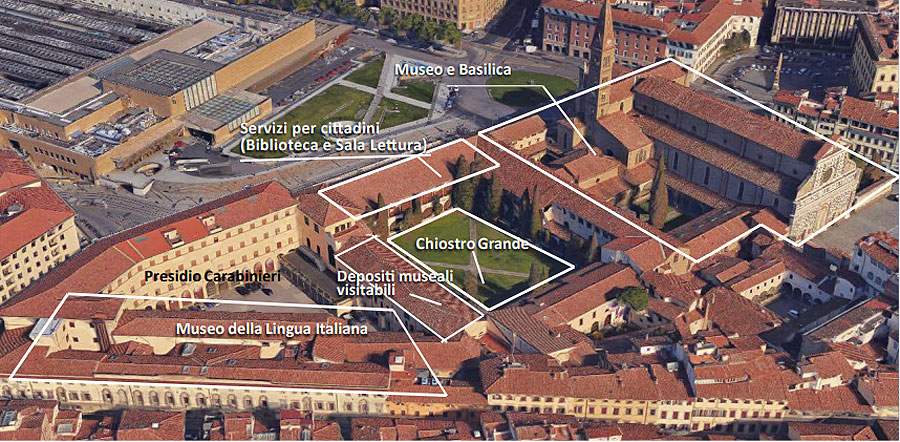Florence, here's how the Santa Maria Novella complex will be reborn
Plans that will lead the Santa Maria Novella complex to become a major new multifunctional space for the city were presented by Florence Mayor Dario Nardella, in the presence of Councillors for Housing Benedetta Albanese, Urban Planning Cecilia Del Re, Real Estate Alessandro Martini and Culture Tommaso Sacchi.
“In Santa Maria Novella,” said Mayor Nardella, "a large multifunctional hub will be born, strategic from the point of view of location and mobility, linked to culture, creativity, craftsmanship, sociality, almost a new city neighborhood, a unicum at the Italian and European level. The spaces are designed for residents, tourists, families, young people, artists: the strength of this complex lies in being a multifaceted place that will act as a great magnet capable of attracting different generations."
Work has already been partly started, will be carried out in stages, and a total investment of 20 million euros has been estimated in this regard. The museum area will be enlarged (part of which can also be dedicated to the Alinari Foundation) and the entire complex will include new visitable warehouses, exhibition spaces, events and performances in the Great Cloister, the Museum of the Italian Language, social housing, showrooms for artisans, creativity and innovation start-ups, ateliers for contemporary art, and the garrison of the Carabinieri.
Forty-five hundred square meters will be dedicated to social housing: they will be divided into about fifty apartments to be used for rent for young couples, so as to encourage the return of residence to the center. As for museum expansion projects, there will be a new monumental entrance from Station Square, with a reception hall (which will include ticket office, checkroom and refreshment facilities totaling 800 square meters), and exhibition spaces for permanent and temporary collections (620 and 680 square meters, respectively). Some rooms will be able to house part of the Alinari archives, in agreement with the Foundation and the Tuscany Region. Then there will be a new library (600 square meters, connected to the Dominican library) and the museum deposits and archives that will become open to visitors. The latter will cover about 1100 square meters and will house paintings, furniture, art objects and sculptures. This solution will make it possible to enhance dismembered pictorial cycles, study them, and plan conservation interventions of the works aimed at eventual relocation or exhibition. Goods belonging to other civic museum collections currently scattered in other inadequate external storage facilities will also be reorganized and transferred to the new repositories. The photo library of the Museums Service will also be housed within the complex: formally established in the early twentieth century to document both works of art and monumental buildings pertaining to the City of Florence, the photo library now brings together some 112,000 assets with various fonds of phototypes, consisting of plate and film negatives and paper positives, in transparency and in digital format. Its holdings consist of some historical funds, including the Baccani fund, the Belle Arti fund and the Stefano Bardini fund, as well as many prominent authors of the Italian photographic scene (Alinari, Brogi, Anderson) and significant local personalities (Cipriani, Barsotti). The Monastero Nuovo part will also house the Museum of the Italian Language: on a total area of 2,500 square meters divided on the ground and second floors. The cost is 4.5 million euros and by the end of 2021 a first batch of interventions is scheduled to begin.
Santa Maria Novella will also become a hub of creativity aimed at youth entrepreneurship, artists and artisans: in fact, a showroom for quality craftsmanship, a Kunst Halle for exhibitions of young artists who will also have space for residencies will be located in the New Monastery. The Great Cloister will be increasingly used for the cultural performances of the Florentine Summer and for major international events. For the first time, some rooms on the third and attic floors will be reserved for institutional guests of the City Council.
With an entrance from Station Square, a 24-hour Carabinieri Station will remain, as agreed with the Arma: work is completed and the move to the complex is being planned. In the complex, what is now an indoor parking lot will eventually become a new freely accessible square that will be central among the apartments, the new Language Museum and the creative workshops.
 |
| Florence, here's how the Santa Maria Novella complex will be reborn |
Warning: the translation into English of the original Italian article was created using automatic tools. We undertake to review all articles, but we do not guarantee the total absence of inaccuracies in the translation due to the program. You can find the original by clicking on the ITA button. If you find any mistake,please contact us.





























